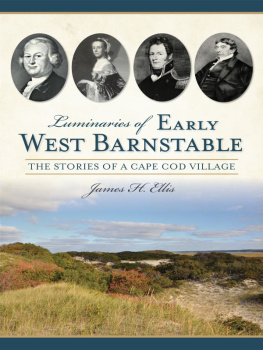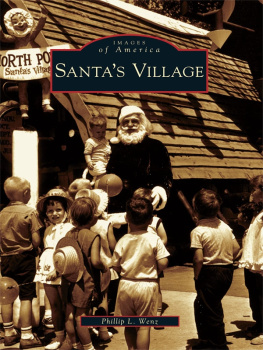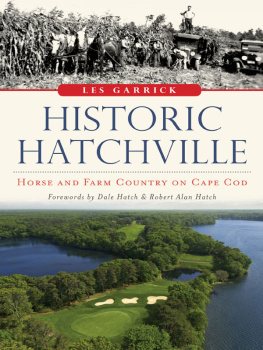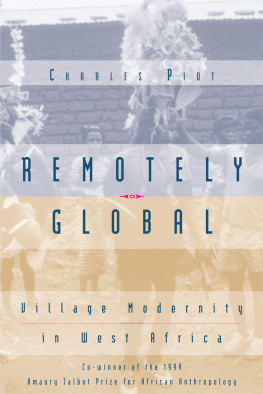
West Barnstable map. Courtesy of GIS Unit, Town of Barnstable.

Published by The History Press
Charleston, SC 29403
www.historypress.net
Copyright 2014 by James H. Ellis
All rights reserved
First published 2014
e-book edition 2014
ISBN 978.1.62584.801.7
Library of Congress Cataloging-in-Publication Data
Ellis, James H., 1932
Luminaries of early West Barnstable : the stories of a Cape Cod village / James H. Ellis.
pages cm
Includes bibliographical references and index.
print edition ISBN 978-1-62619-315-4
1. West Barnstable (Mass.)--History. 2. West Barnstable (Mass.)--Biography. I. Title.
F74.W423E45 2014
974.492--dc 3
2014003552
Notice: The information in this book is true and complete to the best of our knowledge. It is offered without guarantee on the part of the author or The History Press. The author and The History Press disclaim all liability in connection with the use of this book.
All rights reserved. No part of this book may be reproduced or transmitted in any form whatsoever without prior written permission from the publisher except in the case of brief quotations embodied in critical articles and reviews.
In memory of a West Barnstable man.
Raymond E. Gilman
PFC, 358th Infantry, 90th Division
August 1, 1915May 1, 1945
Contents
Preface
In a college criminal law class in Michigan, well before the bicentennial focused renewed attention on the cast of characters in the American Revolution, I listened to the professor give an intense description of a 1761 oral argument in a legal case heard in Boston. The subject at hand was search and seizure, and Professor Houts discussed in detail something called writs of assistance at issue in the Boston hearing. Writs of assistance, despised by the colonists, were general search warrants ruthlessly employed by the Crowns enforcement officers. A young lawyer took up the cause of the Bostonians and presented at trial a lengthy and fiery condemnation of the hated writs. John Adams thought that the presentation sparked the Revolution. Never naming the principal actor and by way of conclusion, the professor asked, Now, who was the man who argued the case?
I raised my hand and answered, James Otis Jr.
Professor Houts appeared stunned, seemingly wondering, How in the world did that fellow, here in the Midwest, know the answer? For as long as he had taught the subject, he had always stumped his classes with the questionespecially in Michigan, far removed from old Boston. Little did he know that I was born in West Barnstable, half a mile from the birthplace of Otis, arguably the most important or greatest person ever born on Cape Cod and someone not obscure to me.
Later, I told my grandfather Henry A. Ellis about the byplay. He was a prominent Hyannis attorney and an avid student of history. Amused, he responded with a point I thought worth exploring. In his view, apparently no other village in the country outside of West Barnstable made a greater contribution to the nations early leadership over such a short span of years. In addition to Otis (17251783), there was his sister, activist author Mercy Otis Warren (17281814); U.S. Navy captain John Percival (17791862); and Massachusetts chief justice Lemuel Shaw (17811861)all born in the little village. The New England historian John G. Palfrey at the Barnstable centennial celebration in 1839, in discussing James Otis Jr., narrowed the claim and advanced the contention that outside of the birthplace of George Washington, No spot in the country has made such a gift to the country, as the spot called Great Marshes (now West Barnstable). Palfreys assessment was made without including Percival and Shaw, both in attendance, and their yet-to-be-judged contributions, as well as the merits of the often-overlooked Mercy Otis Warren.
One must keep in mind that West Barnstable is not an incorporated town or municipality. Instead, it is what New Englanders call a villagean informally designated section of a township. West Barnstable is situated in the northwest corner of the town of Barnstable in the middle portion of Cape Cod and is one of seven principal villages in the town. Throughout history, it has been the most rural part of town, and its population in the eighteenth century likely did not match that of other villages in town, such as Barnstable village (the county seat), Hyannis (the up-and-coming business center), Osterville and Cotuit. Part of the reason for its smaller population is the fact it does not have direct access to the sea. The aforementioned four villages were active ports, and in the early years of the country, the ocean served as the highway for commerce and communications. In the first national census in 1790, the entire town reported a total of 2,610 inhabitants. Village breakdowns were not provided. Thus, one can only estimate the West Barnstable population that produced four national, if not international, figures in the half-century period between 1725 and 1781. A fair guess would be less than 500.
I took up my grandfathers challenge, so to speak, and wrote a newspaper piece on West Barnstables exceptional contributions to the countrys leadership and history. But in the back of my mind, it always seemed a subject worthy of a book. In 2014, the Town of Barnstable will hold a yearlong celebration of its 375th anniversary, and this seems as good a time as any to present the West Barnstable chapter of the towns and the nations story.
Acknowledgements
John Burke of West Barnstable and John Adams of Orleans Camera provided invaluable assistance with the photo and imaging processes, thereby adding a special dimension to this book.
As might be expected with a book on this subject, Sturgis Library of Barnstable and Whelden Memorial Library of West Barnstable contributed a great deal to the necessary research.
Louis Cataldo, the dean of Cape Cod historians, and Tess Korkuch at the Barnstable CountyCataldo Archives added to the work, as did the GIS Unit of the Town of Barnstable and the U.S. National Archives.
As always, my wife, Ruthie, a daughter of West Barnstable, contributed background information, continuous support and editorial help at every step of the way.
The personnel at The History Presschiefly my commissioning editor, Katie Orlando, and my project editor, Ryan Finn, but also Jeffrey Saracenomade the end product possible.
To the foregoing, I express my gratitude.
CHAPTER 1
The Great Marshes
In the mid-1800s, Henry David Thoreau thought that development had gotten out of hand in the rural White Mountains of New Hampshire. I might have supposed that the main attraction of that region, even to citizens, he opined, lay in its wildness and unlikeness to the city, and yet they make it as much like the city as they can afford to. Sandy Neck is a six-mile-long, half-mile-wide dynamic barrier spit shielding the Great Marshes to its south. On summer weekends, its beachfront is overwhelmed with hundreds of recreational camper and sports utility vehicles lined up cheek-by-jowl above the waterline. They come from near and far, dragging along personal watercraft, boats and rafts. Television antennas poke skyward. Flags wave, dogs bark and bonfires glow. The scene is not unlike a World War II invasion beachhead. The beachgoers have carried urban and suburban life on their backs. This is the present state of a prominent natural aspect of the Mid-Cape village of West Barnstable. It did not begin this way.
Next page













